Important
Threat and vulnerability management can help identify Log4j vulnerabilities in applications and components. Learn more.
Threat and vulnerability management uses the same signals in Defender for Endpoint’s endpoint protection to scan and detect vulnerabilities.
The Weaknesses page lists the software vulnerabilities your devices are exposed to by listing the Common Vulnerabilities and Exposures (CVE) ID. You can also view the severity, Common Vulnerability Scoring System (CVSS) rating, prevalence in your organization, corresponding breach, threat insights, and more.
Note
If there is no official CVE-ID assigned to a vulnerability, the vulnerability name is assigned by threat and vulnerability management.
Tip
To get emails about new vulnerability events, see Configure vulnerability email notifications in Microsoft Defender for Endpoint
Navigate to the Weaknesses page
Access the Weaknesses page a few different ways:
- Selecting Weaknesses from the Vulnerability management navigation menu in the [Microsoft 365 Defender portal] (portal-overview.md)
- Global search
Navigation menu
Go to the Vulnerability management navigation menu and select Weaknesses to open the list of CVEs.
Vulnerabilities in global search
- Go to the global search drop-down menu.
- Select Vulnerability and key-in the Common Vulnerabilities and Exposures (CVE) ID that you’re looking for, then select the search icon. The Weaknesses page opens with the CVE information that you’re looking for.

- Select the CVE to open a flyout panel with more information, including the vulnerability description, details, threat insights, and exposed devices.
To see the rest of the vulnerabilities in the Weaknesses page, type CVE, then select search.
Weaknesses overview
Remediate the vulnerabilities in exposed devices to reduce the risk to your assets and organization. If the Exposed Devices column shows 0, that means you aren’t at risk.

Breach and threat insights
View any related breach and threat insights in the Threat column when the icons are colored red.
Note
Always prioritize recommendations that are associated with ongoing threats. These recommendations are marked with the threat insight icon ![]() and breach insight icon
and breach insight icon ![]() .
.
The breach insights icon is highlighted if there’s a vulnerability found in your organization. 
The threat insights icon is highlighted if there are associated exploits in the vulnerability found in your organization. Hovering over the icon shows whether the threat is a part of an exploit kit, or connected to specific advanced persistent campaigns or activity groups. When available, there’s a link to a Threat Analytics report with zero-day exploitation news, disclosures, or related security advisories.
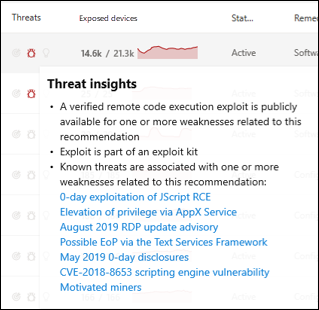
Gain vulnerability insights
If you select a CVE, a flyout panel will open with more information such as the vulnerability description, details, threat insights, and exposed devices.
- The “OS Feature” category is shown in relevant scenarios
- You can go to the related security recommendation for every CVE with exposed device
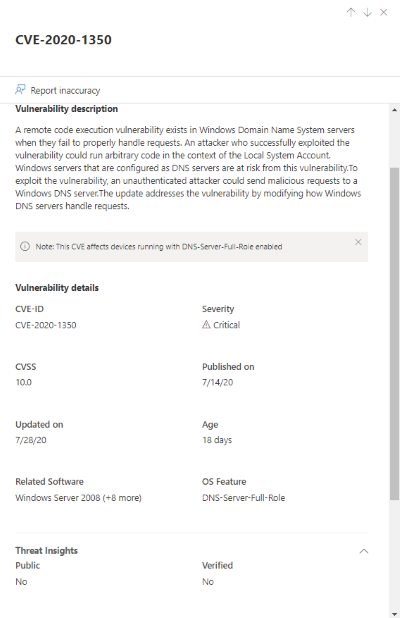
Software that isn’t supported
CVEs for software that isn’t currently supported by threat & vulnerability management is still present in the Weaknesses page. Because the software is not supported, only limited data will be available.
Exposed device information will not be available for CVEs with unsupported software. Filter by unsupported software by selecting the “Not available” option in the “Exposed devices” section.

View Common Vulnerabilities and Exposures (CVE) entries in other places
Top vulnerable software in the dashboard
- Go to the threat and vulnerability management dashboard and scroll down to the Top vulnerable software widget. You will see the number of vulnerabilities found in each software, along with threat information and a high-level view of device exposure over time.
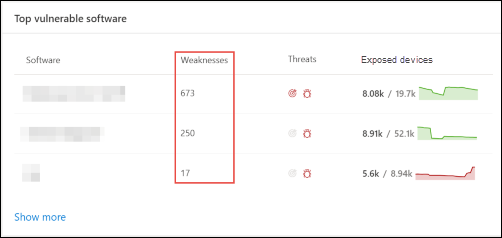
- Select the software you want to investigate to go to a drilldown page.
- Select the Discovered vulnerabilities tab.
- Select the vulnerability you want to investigate for more information on vulnerability details
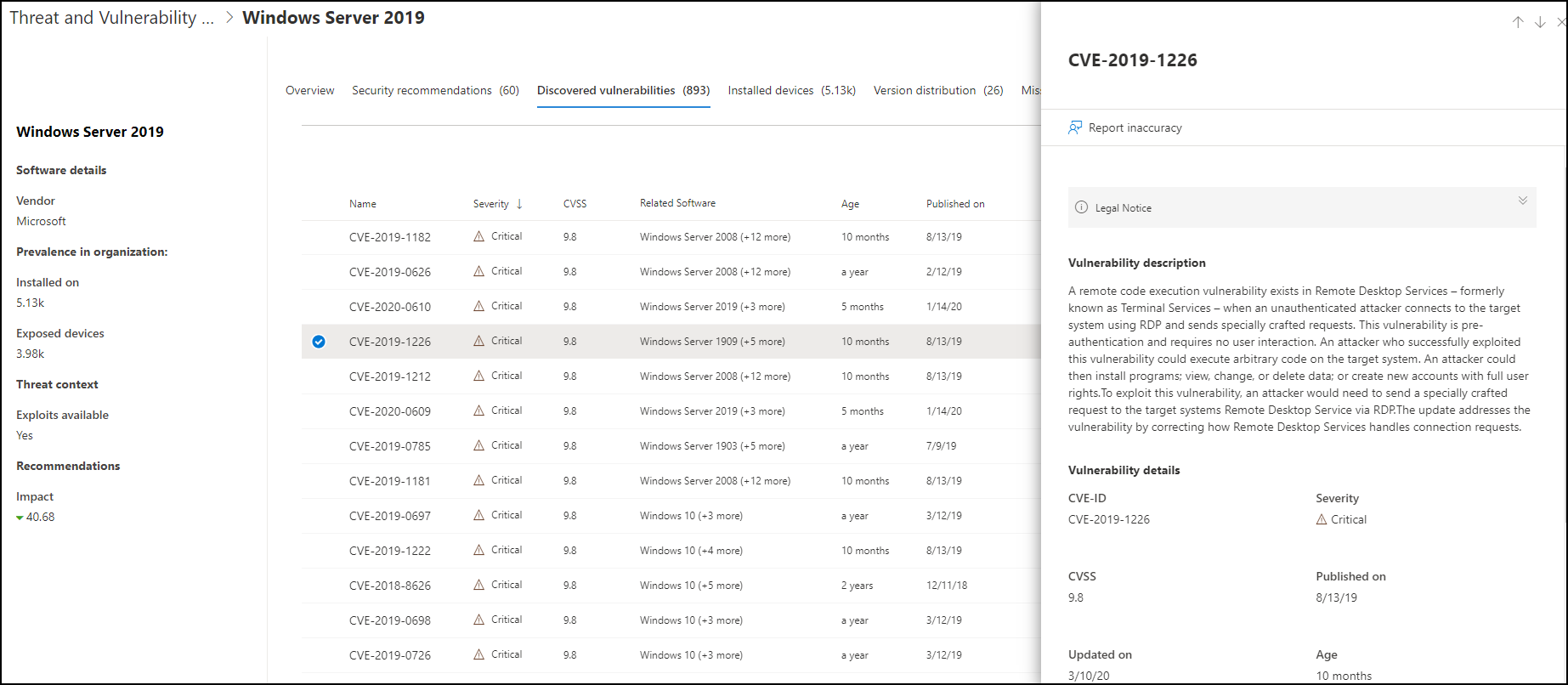
Discover vulnerabilities in the device page
View related weaknesses information in the device page.
- Go to the Microsoft 365 Defender navigation menu bar, then select the device icon. The Device inventory page opens.
- In the Device inventory page, select the device name that you want to investigate.
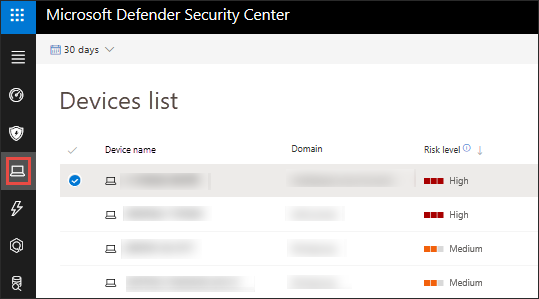
- The device page will open with details and response options for the device you want to investigate.
- Select Discovered vulnerabilities.
- Select the vulnerability that you want to investigate to open up a flyout panel with the CVE details, such as: vulnerability description, threat insights, and detection logic.
CVE Detection logic
Similar to the software evidence, we now show the detection logic we applied on a device in order to state that it’s vulnerable. The new section is called “Detection Logic” (in any discovered vulnerability in the device page) and shows the detection logic and source.
The “OS Feature” category is also shown in relevant scenarios. A CVE would affect devices that run a vulnerable OS only if a specific OS component is enabled. Let’s say Windows Server 2019 or Windows Server 2022 has vulnerability in its DNS component. With this new capability, we’ll only attach this CVE to the Windows Server 2019 and Windows Server 2022 devices with the DNS capability enabled in their OS.
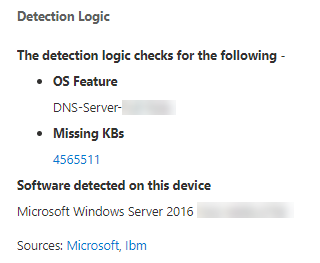
Report inaccuracy
Report a false positive when you see any vague, inaccurate, or incomplete information. You can also report on security recommendations that have already been remediated.
- Open the CVE on the Weaknesses page.
- Select Report inaccuracy and a flyout pane will open.
- Select the inaccuracy category from the drop-down menu and fill in your email address and inaccuracy details.
- Select Submit. Your feedback is immediately sent to the threat and vulnerability management experts.


